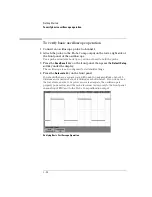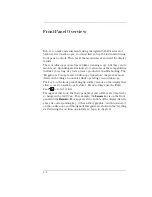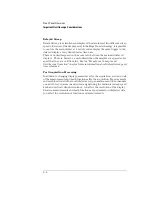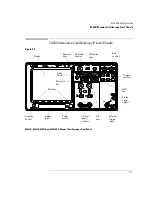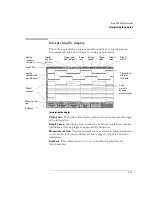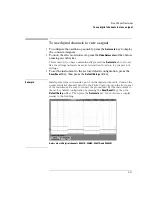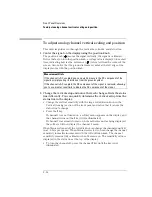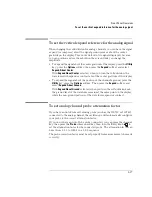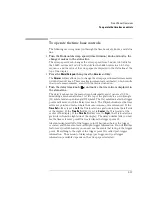
2- 4
Front-Panel Overview
Important Oscilloscope Considerations
Whether the oscilloscope is stopped or running, you see more detail as you zoom
in, and less as you zoom out. Zoom means you expand the waveform using
either the main or delayed sweep window. Panning the waveform means you
use the Horizontal Delay time knob(
)to move it horizontally. To keep from
losing detail as you zoom out, switch to the Peak Detect acquisition mode.
Peak Detect acquire mode
Peak Detect for the 54620-series and for the
54640-series functions as follows:
•
54620-series
In Peak Detect acquisition mode, any noise, peak, or signal
wider than 5 ns will be displayed, regardless of sweep speed. In Normal
acquisition mode, at sweep speeds faster than 1 ms/div, you would see a 5-ns
peak, so peak detect has no effect at sweep speeds faster than 1 ms/div.
•
54640-series
In Peak Detect acquisition mode, any noise, peak, or signal
wider than 1 ns will be displayed, regardless of sweep speed. In Normal
acquisition mode, at sweep speeds faster than 500
µ
s/div, you would see a
1-ns peak, so peak detect has no effect at sweep speeds faster than 500
µ
s/div.
Using Peak Detect and infinite persistence together is a powerful way to find
spurious signals and glitches.
Average acquire mode
Averaging is a way to pull a repetitive signal out of
noise. Averaging works better than either a brightness control or a bandwidth
limit because the bandwidth is not reduced except when in high resolution mode
(number of averages=1) is selected.
The simplest averaging is high-resolution mode (number of averages = 1). For
example, on the 54620-series, the sample rate at a Time/Div setting of 2 ms/div
allows the extra 5-ns samples to be smoothed together, smoothing the data into
one sample, which is then displayed. Averaging (number of averages > 1) needs
a stable trigger, because in this mode multiple acquisitions are averaged
together. See the “MegaZoom Concepts and Oscilloscope Operation” chapter
for more information about high resolution mode.
Summary of Contents for 54621A
Page 4: ...iv ...
Page 10: ...Contents 6 ...
Page 11: ...1 Getting Started ...
Page 38: ...1 28 ...
Page 39: ...2 Front Panel Overview ...
Page 63: ...3 Triggering the Oscilloscope ...
Page 117: ...4 MegaZoom Concepts and Oscilloscope Operation ...
Page 171: ...5 Making Measurements ...
Page 222: ...5 52 Making Measurements Making overshoot and preshoot measurements ...
Page 223: ...6 Utilities ...
Page 239: ...7 Performance Characteristics ...
Page 250: ...7 12 Performance Characteristics Agilent 54620 series Performance Characteristics ...
Page 260: ...7 22 ...





